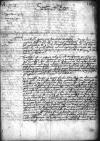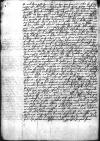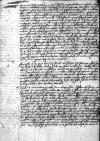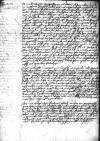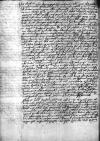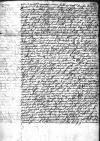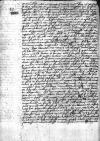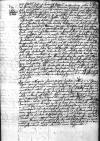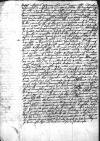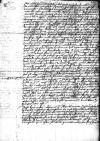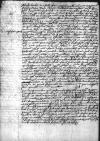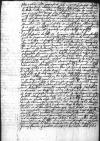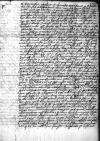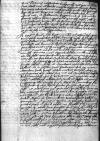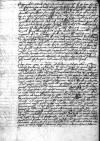⌊⌋ ⌊hinc⌋ novissime Serenissimae Maiestati Vestrae 1530-07-02⌊II huius mensis1530-07-02⌋ duplicatas de his, quae tum hic agebantur et quod cubicularius ⌊Steinkircher⌋ cum ⌊⌋ Serenissimae Maiestatis Vestrae 1530-06-28⌊XXVIII Iunii1530-06-28⌋ praeteriti ad me applicuisset etc., unde ea ad praesens repetere putavi supervacaneum. Ab eo tempore quae se obtulerunt, sic habent.
Tractatum est in negotio religionis ab utraque parte per continua consilia, quae et in praetorio et in palatio ⌊caesaris⌋ sunt habita, sed hucusque nihil aliud factum, quam quod minis ad resipiscendum ⌊Lutheranos⌋ nostra pars adigere conatur, quod tamen vix arbitror posse fieri, adeo plebs utriusqe partis hac labe est infecta, quod si etiam principes vellent, vulgus, quod hoc virus altius hausit, nequaquam induci possit; unde adhuc tractatur. Quae postea se offerent, Maiestatem Vestram Serenissimam non latebunt.
In ⌊⌋ scripsi, quod serenissimus ⌊Ferdinandus rex⌋ eo die, quo illas dedi, pro me mittere debuisset, quemadmodum per suum mihi cubicularium significaverat, sed vocatio ista nescio ob quae negotia in posterum diem fuerat prorogata. Miserat tandem pro me ⌊comitem de Nogarollis⌋ et me sine arbitris seorsum admisit humanissimeque excepit et antequam ordiebar loqui, ⌊ille⌋, quod prius in ⌊Nova Civitate⌋ a Maiestate Vestra Serenissima apud eum fuerim, mentionem fecit seque, quod tardius pro me miserit, excusavit. Tandem cum me loqui permitteret, exposui, facta prius salutatione a Maiestate Vestra Serenissima, melioribus quibus potui modis ea, quae per litteras mihi Maiestas Vestra Serenissima mandaverat. Ad salutationem amicis et bonis verbis habuit Maiestati Vestrae Regiae gratias se vicissim offerendo, ubi illi gratificari posset et pro ea confidentia, quam Maiestas Vestra Serenissima haberet, non velle firmare consilium suum in matrimonio cum illustrissima ⌊filia⌋ sua proposito sine eius amico arbitrio, respondit rem esse arduam in talibus consulere, unde velit deliberare et mature mihi respondere. Ad praesens vero, inquit, dico dominum ⌊Ludovicum ducem Bavariae⌋ bonum et nobilem esse principem et hoc pro hac vice vobis do pro responso, de reliquo deliberabo. Inde dixi, quod per ⌊⌋ mihi Maiestas Vestra Serenissima mandasset, ut negotium illustrissimi domini marchionis ⌊Georgii Brandenburgensis⌋ maiestati eius plurimum commendarem, recensens quaedam de hoc negotio ad longum et quod si contingeret assistere ipsi domino marchioni, ne maiestas sua aegre ferret, aut alterius me partis, de factione Lutherana me esse existimaret; ad ea subrisit dicens, ex litteris Serenissimae Maiestatis Vestrae intellexisse, me ab ea secta esse alienum, precabaturque mihi in eo statu, in quem me Maiestas Vestra Serenissima posuisset, felicitatem. Ad negotium ⌊marchionis Georgii⌋ respondit, se boni consulturum, quod ei adsum et quod ipse etiam et deberet et libenter velit, quantum aequitas fert, illi favere in omnibus. Hinc de veteri notitia mecum colloquebatur et de rebus, quae ante novem annos in ⌊Nova Civitate Austriae⌋ acta fuerunt, et inter alia incidit sermo, quod ex ⌊Polonia⌋ quidam proficiscuntur sub praetextu peregrinationis Romanae, qui a ⌊palatino Transsilvaniae⌋ litteras ad hostes perferunt; respondi, quod tales merito deberent puniri et detineri, non tamen igitur omnibus istae difficultates in profectionibus suis ingeri deberent. Respondit: qui habituri sunt litteras serenissimi ⌊regis⌋ aut ⌊reginae⌋ vestrae, illorum manibus subscriptas, libere permittentur, sigillo vero et secretariis vestris non semper tuto creditur, et tales, qui huiusmodi litteras ab hostibus meis perferunt, apud vos non puniuntur. Respondi, Maiestatem Vestram Serenissimam ingens et apertum habere regnum et non posse scire de omnibus, quae in eo geruntur, quemadmodum neque maiestas sua potest occludere viam, quin vel aliqui saltem non in ⌊Galliam⌋ et alibi ad hostes se conferant, et quod ea in re nulla culpa Maiestati Vestrae Serenissimae impingi potest, cum semper id ex se fecerit, quod bono fratri et amico atque vere Christiano regi convenit, et quod non deberet credere falsis delationibus, quae a malis hominibus et pacis turbatoribus plerumque deferuntur, et si quid in his per me scribi velit Serenissimae Maiestati Vestrae, ut mihi hoc committeret, offerens ei operam meam, quandoquidem ad nihil fere aliud hic a Maiestate Vestra Serenissima essem iam per tot annos relictus, quam ut eam mutuam benevolentiam et coniunctionem, quae est inter ⌊caesaream maiestatem⌋ eumque atque Maiestatem Vestram Serenissimam, quoad eius a me fieri posset, redderem in dies ampliorem et auctiorem et quod ea in re nullam unquam diligentiam aut studium omiserim. Respondit, se id iam habere et ab ipso ⌊caesare⌋ compertum, et se vicissim valde clementer mihi exhibuit. Ad alia vero data opera, ut mihi visum est, non respondit et sic me cum frequenti birretti depositione humanissime a se dimisit.
Iste fuit primus actus istius comoediae; quod reliquum est, servato rerum hic gestarum ordine progressus scriptionis feret.
Unum hoc addendum censui, quod paene omiseram inter loquendum cum serenissimo domino ⌊Ferdinando rege⌋: commendavi etiam ei negotium Prutenicum, quod si forsan in his comitiis super hoc agi quippiam deberet, ut Maiestati Vestrae Serenissimae adesset, neque permitteret, ut quicquam in praeiudicium Maiestatis Vestrae et regni eiusdem statueretur ob conservandam publicam ⌊orbis Christiani⌋ tranquillitatem. Quod rationibus quibus potui melioribus deduxi. Ad ea, cum me satis diu serio aspexisset, in leviusculum risum conversus respondit: ⌊ego⌋ vos nolo decipere et aliud dicere, quam sentio, quod mihi non convenit; debetis scire, quod ego iam promisi assistentiam ⌊magistro Ordinis in Alemania⌋, et si hoc non fecissem, ego ea facerem, quae petitis. Respondi, quod Maiestas Vestra Serenissima sibi non persuasisset, quod ea in re ⌊maiestatem eius⌋ habere deberet in contraria parte, cum tamen maiestas sua huic parti per promissum sic esset addicta, non conveniret, quod iustitiae Serenissimae Maiestati Vestrae deberet adversari, qua de re rogavi, ut ob mutui amoris et Christianae tranquillitatis conservationem huic ⌊Ordini⌋ plus aequo non faveret, ad quod hilariori vultu respondit: non faciam aliud, quam quod aequitas expostulat. Hinc facilis est coniectura, quid iste ⌊Ordo⌋ seu potius confusio, adhuc moliatur. Et cum iam in hanc materiam inciderim, quaedam latius non abs re scribenda putavi.
Observavi hic, quantum a me fieri potuit, ⌊magistri in Alemania⌋ et ⌊Ordinis⌋ eius consilia et molimina, fuitque bonus magister cum primis, postquam ⌊caesar⌋ huc applicuisset, qui querelas et articulos contra illustrissimum dominum ⌊marchionem ducem in Prussia⌋ et nescio quae alia proponeret, petens feudum a caesare, quod, ut mihi illustrissimus ⌊dominus de Nassau⌋ retulit, in ea forma, ut praedecessores eius in ⌊Alemania⌋ suscipere fuerunt soliti, concedere caesar promisit.
Ipse ⌊magister⌋ cum suis fratribus, quos paucos secum habet, ad omnes principes comites et nobiles ⌊Germaniae⌋ se ingerit, conquerens hospitale nationis Alemaniae per illustrissimum dominum ⌊marchionem Albertum⌋ alieno dominio subiectum et a ⌊Germanis⌋ amotum, omnium implorans opem et auxilium, habetque principes plures, cum quibus se plerumque ad palatium recipere solet; inter eos est dominus ⌊dux Brunsvicensis⌋ cum fratre, quem libenter faceret magistrum in ⌊Livonia⌋, et ipse magister summopere desiderat esse in ⌊Prussia⌋, qua in re et titulos quaerit et feudum, quod tamen ei, ut spero, non dabitur, nisi in forma generali, ut aliis in ⌊Alemania⌋ magistris datum est. Et cum Maiestas Vestra Serenissima, quomodo me in his gerere debeam, nullam aliam instructionem mihi dederit, quam si quid adversum Maiestatem Vestram Serenissimam vel dominum ⌊Prussiae ducem⌋ dici vel agi senserim, strenue et prudenter defenderem, sicut et honos Maiestatis Vestrae Serenissimae
et mea erga Maiestatem Vestram Serenissimam fides expostulare videbuntur, huic mandato Maiestatis Vestrae Serenissimae iam in parte satisfeci et satisfacio pro virili mea, ubi id expedire cognosco, indies. Eguissem tamen, si quid in his solidi per me fieri deberet, latiori informatione et singulari mandato, quo fretus et obiectis respondere et ubi necesse foret, protestari potuissem vel de iniuria aut gravamine, si quod in his ⌊comitiis⌋ negotiis Maiestatis Vestrae Serenissimae iniceretur. Ad praesens hoc feci et facio, quod possum.
Fiunt hic mirabiles practicae et nescio quae castra in aëre construuntur, et interea, quae potiora sunt, negligimus. De expeditione in ⌊Turcas⌋, qui fere in visceribus nostris agunt, ne verbum quidem neque video, quibus modis aliquid serii in eos hostes statui possit, cum hic inter nos hostes simus. Misit hinc superiori die serenissimus ⌊Ferdinandus rex⌋ duos ad ⌊Turcarum imperatorem⌋ oratores, sperans nescio quid ab eo consequi et cum ea legatione factioni adversae metum incutere. Utinam succedat et quod hinc ⌊orbis Christianus⌋ componi possit, ego tamen meo rudi iudicio nihil tale futurum cognoscere possum. Fortassis tandem Deus nostri misertus declinabit in nos misericordiam suam, qua egemus maxime. Accessit etiam, quo hic sumus facti animosiores, quod prima istius Iulii serenissimus ⌊Galliae rex⌋ ⌊liberos⌋ suos redemit, datis duodecim centenis millibus ducatorum et completis articulis nuper in ⌊Cambray⌋ confectis, unde multorum est opinio, quod ea inter istos principes amicitia durare debeat. Utinam! Nihil hoc tempore rebus Christianis adeo inclinatis accidere posset opportunius et commodius. Sunt tamen, qui secus eventurum putant. Rei exitus docebit.
Sed ut revertar, unde sum digressus: conventum fuit, ut scripsi in novissimis, inter principes, qui illustrissimo domino ⌊marchioni Brandenburgensi Georgio⌋ assistunt, de petitione danda serenissimo ⌊Ferdinando regi⌋, quae nihil aliud acredinis in se habuit, quam quod si dominus marchio ius suum consequi non posset, ne foret illi necesse amicos suos iterum pro consilio impetere, et postquam in ecclesia convenissemus, illustrissimus ⌊Ioannes elector⌋ et ⌊Georgius⌋, duces ⌊Saxoniae⌋, ⌊Ludovicus Bavariae⌋ et ⌊Albertus Mekelburgiae⌋ duces, cum aliis plerisque ducibus et comitibus, defuit nobis ⌊lantgrabius Hessiae⌋, quem cum aliquamdiu exspectassemus et non veniret, processimus in ordine versus hospitium serenissimi ⌊Ferdinandi regis⌋, qui nobis usque ad gradus venerat obviam, et omnes data manu excepit, et nos in aulam, ubi prandere solet, praecessit. Quo postquam pervenimus, me primum ab aliis sevocavit et mihi dixit, quod aegre ferre non deberem, se tamdiu mihi in negotio Serenissimae Maiestatis Vestrae non respondisse, negotium enim hoc matura deliberatione eguisse, responsurum se post hunc actum. Habui ⌊maiestati eius⌋ gratias vicissim inculcans, maiestas sua etiam non aegre ferre deberet, quod in ea societate, religioni nostrae suspecta, venissem, quandoquidem nihil mihi cum illa aliud esset commune, quam
illustrissimi
domini ⌊Georgii marchionis Brandenburgensis⌋ causa Opoliensis. Respondit, non fore sibi ingratum, quod his rebus interessem, quo utriusque partis iustitia notior mihi fieret, et sic me humaniter ad locum meum prope ⌊electorem Saxoniae⌋ a se dimisit. Hinc coeptum est loqui more Germano longo sermone a quodam, cui ab omnibus haec provincia fuit iniuncta et cum haec absoluta fuisset concio, voluimus secedere, quod ⌊rex⌋ non permisit, sed cum suis consiliariis se in quendam angulum retraxit et paulo post ⌊cardinalis Tridentinus⌋ nomine maiestatis suae respondit et petitionem nostram in scriptis dari postulavit. Quod cum factum esset, illustrissimus dominus ⌊Georgius marchio⌋ loqui coepit brevibus, petens, ut in iuribus et iustitia sua conservaretur. Ad haec ⌊rex⌋ ipse etiam Germanice respondit, se omne id facturum, quod aequitas et merita domini ⌊marchionis⌋ exposcerent. Sic conventus iste fuit dissolutus, meque relicto in aula, ipse serenissimus ⌊rex⌋ principes rursus usque ad gradus conduxit.
Cum rediisset, accepit me seorsum in angulum, ubi prius consultaverat, et reposito mihi bireto in caput, dixit: serenissimo ⌊regi vestro⌋ sicut prius, cum apud me fuistis, gratias habeo pro salutatione atque exhibitione per vos facta, et singulariter pro ea confidentia, quam in me habet, quod de ⌊filiae⌋ suae connubio a me petit consilium et cum in talibus rebus et arduis non immerito est deliberandum, distuli hucusque vobis respondere et apud me perpendi, quod connubium hoc, de quo tractatur, Serenitati eius et eiusdem filiae et dignum est, et honestum, atque mihi specialiter gratum, nam
illustrissimus
dominus ⌊dux Bavariae Ludovicus⌋ consanguineus mihi est et singularis amicus. Et haec serenissimo ⌊regi vestro⌋ cum multa salutatione meo nomine pro responso rescribetis.
Hoc me diligenter facturum obtuli et pro ea propensione, qua hoc negotium Serenissimae Maiestatis Vestrae prosequeretur, gratias habui. Sicque in omnium conspectu honorifice dimissus abii, a ⌊comite Nogarollis⌋ et domino ⌊Bresinger⌋ archimagistro suae maiestatis ad hospitium meum conductus, qui tunc mecum manserunt in prandio, de multis mecum, quasi de industria ad hoc instructi, disputantes, quae his inserere duxi supervacaneum. Et hoc est responsum mihi datum, quod prius mittere non potui.
His diebus etiam feci expeditionem meam ad ⌊urbem⌋ pro obtinenda confirmatione episcopatus Culmensis, quem mihi Serenissima Maiestas Vestra non ob mea merita, quae nulla esse censeo, sed ex singulari sua in me dedit gratia, quam utinam vel saltem aliqua ex parte mereri aliquando possem, ad quod hoc corpus, quamdiu in eo spiritus est, cum omni fide studio et servitiis, quae umquam praestare potero, Serenissimae Maiestati Vestrae humillime offero, sic me, Deo duce, semper exhibiturus, ne hoc beneficium nimis indigno contulisse videri et ansam retractandi Maiestas Vestra Serenissima habere possit.
Et cum iam Maiestas Vestra Serenissima in hanc me dignitatem ponere dignata fuerit, me etiam in ea conservare dignetur et praesertim contra magnificum ⌊palatinum Pomeraniae⌋, qui ⌊praedecessoris⌋ mei, fratris sui, omnia meliora bona contra aequitatem omnem et usum ecclesiae Culmensis abstulit, et cum his ad Maiestatem Vestram Serenissimam provocavit, non satis habens, quod ex paupere nobili, cui praeter villam ⌊Conopat⌋ nihil fuit reliquum, factus sit ex ⌊ecclesia Culmensi⌋ dives dominus et palatinus. Qua de re Maiestati Vestrae Serenissimae humillime supplico,
velit eidem ⌊palatino Pomeraniae⌋ serio mandare, ut omnia, quaecumque post mortem fratris sui ⌊episcopi Culmensis⌋ abstulit et ad se recepit, facto veridico inventario, in sequestrum apud Maiestatem Vestram Serenissimam vel in alio loco, ubi tutum Maiestati Vestrae Serenissimae videbitur, usque ad meum reditum deponat, quandoquidem
reverendissimus
olim episcopus Culmensis, frater eius, in episcopatu Culmensi omnia repperit integra post mortem reverendissimi ⌊Crapicz⌋ praedecessoris sui usque ad sandalia et camisias, sic quod ne unus quidem assis aut uncia argenti ei fuerit deperdita. Et nunc bonus iste ⌊palatinus⌋ omnia, quae praedecessores reliquerunt et pauca, quae ⌊frater⌋ eius addidit, sibi usurpavit, non recordatus, quid prius ex eo ecclesia Culmensis fecerit, cum serviens apud reverendissimum olim dominum ⌊Lucam episcopum Varmiensem⌋ ne equum quidem proprium habuerit, et ad praesens arces oppida villas et palatinatum per ⌊ecclesiae Culmensis⌋ proventus possideat, quod incomparabili aequitati Maiestatis Vestrae Serenissimae summopere commendo.
Misi cum litteris Serenissimae Maiestatis Vestrae ad
⌊sanctissimum
dominum nostrum⌋ pro obtinenda confirmatione cum reservatione beneficiorum meorum, quae Maiestas Vestra Serenissima mihi ex singulari gratia reliquit, litteras etiam ⌊maiestatis caesareae⌋ primas ad pontificem credentiales, ut vocant, in personam oratoris, quem maiestas sua caesarea habet apud Sedem continuum, et alias ad ipsum oratorem, quibus negotium obtinendae confirmationis maiestas sua magno cum affectu committit, ut per modum brevis sine gravioribus expensis expediri possit. Scripsit etiam ⌊sanctissimo domino nostro⌋ reverendissimus
cardinalis ⌊Campeius⌋ legatus ex animo et diligenter, sed mihi dixit, quod nequaquam per breve expediri posset, unde parum consolationis accepi, quod istiusmodi commendatitiae mihi sunt profuturae. Quapropter egi ⌊hic⌋ cum meis creditoribus, quibus debeo sexingentos ducatos, ut adhuc mecum habeant patientiam, et eas pecunias, quae ex stipendio ⌊reginalis maiestati⌋s mihi provenire debent, per ⌊Velzeros⌋ ⌊Romam⌋ ⌊procuratoribus meis⌋
destinavi, ut cum illis id quod possunt faciant. Non putassem, quod ego etiam contra miseros ⌊Florentinos⌋ impendere debuissem.
Non possum omittere, cum Maiestas Vestra Serenissima de singulis scire cupiat, quin disputationem meam cum domino ⌊Vilhelmo de Rogendorff⌋, qui ⌊Viennae⌋ praefuit in obsidione ⌊Turcarum⌋, in notitiam Maiestatis Vestrae Serenissimae deducam. Rogatus fui ad prandium, ubi erat illustrissimus
dominus ⌊de Nassau⌋ et ⌊marchio de Arschot⌋ cum quibusdam aliis primoribus ex camera ⌊caesaris⌋, fuit inibi etiam dominus ⌊Vilhelmus de Rogendorff⌋ et dominus ⌊Andreas Ungenad⌋, ex consilio serenissimi ⌊Ferdinandi regis⌋, et postquam remotae erant mensae, deambulavi in horto cum illustrissimo
domino ⌊de Nassau⌋, multa cum eo conferens de rebus Prutenis, qui in principio durus fuit contra illustrissimum
dominum ⌊ducem in Prussia⌋ factus, tandem ex longiori colloquio mitior pollicebatur mihi apud ⌊maiestatem caesaream⌋ operam suam. Et cum sic aliquamdiu deambulassemus, suspicatus dominus ⌊de Rogendorff⌋ nos nescio quae alia tractasse, iunxit se nobis cum domino ⌊Ungenad⌋, et is ex composito subinde se domino ⌊de Nassau⌋ applicuit, et dominus de Rogendorff mihi mecumque secedere coepit, et cum iam parumper essemus progressi, ex abrupto ortus est dicere: vos, domini ⌊Poloni⌋, noluistis serenissimum ⌊regem⌋ nostrum iuvare et nobis laborantibus adesse, non reputantes apud vos, quod ⌊Turci⌋ aliquando futuri sunt vobis propinquiores, et quod destructis nobis vos immunes non sitis evasuri. Cum sic me alloqueretur, ad eum etiam modum respondi, nos iam a multis annis aliquoties ⌊Turcos⌋ et alios plerosque infideles cum nostra magna calamitate sustinuisse et fuisse expertos, et neminem nobis ⌊Germanorum⌋ ⌊Boëmorum⌋ vel ⌊Slesitarum⌋ uno equo aut asse tulisse suppetias, immo nos etiam ab eis derisos interdum, quod a tam vilibus gentibus nos defendere non possemus, unde tam crebris in nos irruptionibus factis, cum nemo vicinorum nobis succurreret, et Turci uno anno praeter solitum bis incursionem in terras nostras multis millibus hominum abductis fecissent, et ab alia parte ⌊Tartari⌋ cum ⌊Moscovitis⌋ in foedere Turcaico in nos concitati essent et ⌊orbis Christianus⌋ tot intestinis aestuaret bellis et, cum denique nemo calamitates nostras benevolis inspiceret oculis et in animum admitteret, coacti, ut necessario a Turcis pacem et indutias post
ulassemus, ad quas itidem serenissimum olim ⌊Ludovicum regem⌋ inducere conabamur, sed per ⌊Hungaros⌋ seductus maluit infeliciter confligere. Eas cum ⌊Turcis⌋ indutias, et utinam adhuc haberemus longiores, quibus fidere possemus, nobis infringere neque licuisset neque licet. Nihilominus et a ⌊Turcis⌋, quod ⌊palatinum Transsilvaniae⌋, et a serenissimo ⌊Ferdinando rege⌋, quod contra palatinum non iuverimus male audimus, cum tamen Serenissima Maiestas Vestra neque illi neque alteri ferre opem debuit aut potuerit, ad suos fines ab aliis infidelibus tuendum intenta, sed pro concordia utrinque facienda omnia, quae expedire videbantur, fecerit. ⌊Ille⌋ subintulit: non misistis milites ex ⌊regno Poloniae⌋ pro ⌊voyavoda⌋? Negavi dicens eos, qui in ⌊Hungariam⌋ erant profecti, sua sponte et sine voluntate atque etiam contra mandatum Maiestatis Vestrae Serenissimae ivisse et Maiestatem Vestram Serenissimam nullum unquam militem suis impensis in Hungariam misisse. Sed, inquit, permisistis, ut irent ad ⌊voyavodam⌋. Respondi: sic etiam ⌊rex⌋ vester permisit multos ex suis dominiis et ex ⌊imperio⌋, cuius fuit locumtenens, ire in ⌊Galliam⌋ contra ⌊caesarem⌋. ⌊Ille⌋ inquit: aliud hoc est de ⌊imperio⌋. Immo, inquam, non aliud, sed simillimum. Sic convictus rediit ad primum thema. Sed vos, inquit, etiam spectabit hoc incendium, si nobis male cedet. Non ad nos solum, respondi, ad totum ⌊Christianum orbem⌋ protendetur, nisi communi omnium ope restinguatur, neque vires nostrae aut serenissimi ⌊Ferdinandi regis⌋ tantae sunt, ut ⌊Turcarum⌋ immensae potentiae resistere possint, praesertim cum iam totam fere ⌊Hungariam⌋ sub potestate habeant, fuissetque satius, ut illam modis quibuscumque integram conservassemus, quod postquam facere noluimus, iam experti sumus, quid acciderit, et utinam non subsequantur peiora.
Sic nobis colloquentibus adveniens illustrissimus
dominus ⌊de Nassau⌋ disputationem hanc nostram interpellavit. Quam igitur Maiestati Vestrae Serenissimae ita, ut habita est, descripsi, quo liquidius cognoscat, quid hic vulgus curiae loquatur, cum illi, qui primi sunt in consilio, dicere talia non verentur. Inde iterum cum domino ⌊de Nassau⌋ deambulando secessi, et inter alia hoc colloquium cum domino ⌊de Rogendorff⌋ ei recensui, ad quod mihi dixit non esse incommodum, ut aliquando super his cum serenissimo ⌊Ferdinando rege⌋ convenirem, addens: non dico sine causa! Hinc subinde quaesivi opportunitatem, quo id fieri posset convenientius, quae, ut ex sequentibus Maiestas Vestra Serenissima intelliget, seipsam se obtulit.
Venit ad me[1] missus a serenissimo ⌊Ferdinando rege⌋ dominus ⌊Bresinger⌋ magister coquinae suae maiestatis et honorificis verbis pro 1530-07-24⌊Dominica praeterita1530-07-24⌋ me ad maiestatem eius invitavit ad prandium. Quod cum negare non licuit, eo mihi fuit gratius, quo colloquium hoc, quod cum ⌊maiestate illius⌋ desiderabam, videbam mihi offerri liberius. Cum itaque 1530-07-24⌊postero die1530-07-24⌋ pro me esset missum, inductus fui in hortum adiacentem domui regiae. In ea fuit area asseribus obtecta et antiquis pannis aureis ornata. Inveni ibidem etiam serenissimi ⌊Angliae regis⌋ oratorem cum aulicis plurimis ⌊regem⌋ exspectantibus, qui cum veniret, sequebatur eum ⌊nuntius⌋ ⌊pontificis⌋, serenissimi ⌊regis Galliae⌋ orator, cum ⌊Venetorum⌋, ⌊Ferrariae⌋ et ⌊Mantuae ducum⌋ oratoribus. Cumque humaniter essemus excepti et ⌊rex⌋ manus lavisset, ad nos itidem aqua fuit delata. Post ablutionem consedimus: ⌊rex⌋ prior et prope illum ⌊nuntius⌋ ⌊pontificis⌋, hinc Galliae Angliae et ego oratores, deinde reliqui. Ferebanturque semper tria fercula iuncta ante ⌊regem⌋ et alia tria similia ante nos eodem modo cocta, factaque fuit ista ferculorum prolatio durante prandio decies, regio luxu omnia instructa, dulcique musica, quae ibi frequens fuit, condita. Inter prandendum serenissimus dominus ⌊rex⌋ libere fere cum omnibus colloquebatur de variis et deventum ad ⌊Germaniam⌋, quam dixit, si unius esset domini, ut regnum ⌊Franciae⌋ aut ⌊Angliae⌋, nullum esse in Christianitate regnum potentius, et dixit de civitatibus 72 de ⌊Hansa⌋, quas Vandalas vocant, subiacentes imperio, quod illae solae possent plurima, et ignorabat maiestas sua, quod vocarentur Vandalae. Unde de ⌊Vandalis⌋ habuimus sermonem, quos lingua uti Polona asserebam, sicut ⌊Cassubae⌋ et adhuc in hodiernum quidam rustici in propinquis villis ⌊Lubeci⌋, dixique de his septuaginta duabus civitatibus plurimas non subesse ⌊imperio⌋, ut est in ⌊Moscovia⌋ ⌊Novogardia⌋, in ⌊Livonia⌋ ⌊Riga⌋ et ⌊Revalia⌋, in partibus ⌊Germaniae⌋ inferioribus ⌊Antverpia⌋ ⌊Brugis⌋ ⌊Gandavum⌋, in ⌊Prussia⌋ Maiestati Vestrae Serenissimae subiecta ⌊Gdanum⌋ et ⌊Elbingum⌋, quae tamen malo quodam abuso sub imperium vocarentur, cum illi non pareant. ⌊Rex⌋ respondit se aliter edoctum, sed si sic esset, aliter etiam rem habere et cum post alios plerosque sermones finis esset prandii post datam aquam mensam reliquimus, et sic stantes maiestas sua primum vocavit ad se oratorem ⌊Franciae⌋ et cum illo colloquebatur aliquamdiu. Deinde illo dimisso, qui ad me applicuit, habuit sermonem cum oratore Veneto, ego interim cum oratore Gallo viro admodum humano colloquebar. Is mihi dixit, quod ⌊regi⌋ dixisset, cum iam dominus suus serenissimus ⌊rex Franciae⌋ omnia exsecutus esset et complevisset, quae per tractatus novissimos in ⌊Cambray⌋ fuissent conclusa, et ⌊sororem⌋ eius in coniugem duxisset, dandam esse operam, quod ista mutua amicitia et coniunctio quam diutissime duraret, innuendo, ne iterum praeberent ansam novis turbis, quae facili ex causa animis prius in sese exulceratis et nondum satis ex recentibus plagis consolidatis oriri possent. Sic nobis colloquentibus accessit ⌊rex⌋ et quaesivit, quo sermone loqueremur. Respondimus: et Italo et Hispano. Dixit ad me: Quid vobis videtur iste Gallus, qui ultra 20 annos versatus est in ⌊Italia⌋, an aliquid intelligat? Respondi: non aliquid solum, sed plurima. Et hinc cognoscens, quod mecum seorsum loqui voluit, relicto oratore Gallo ad ⌊eum⌋ me contuli et prior exorsus habui maiestati eius gratias pro honore, quem Serenissimae Maiestati Vestrae in meam personam exhibuisset, et sicut in prima audientia inculcavi, quod maiestas sua neque per nationes odio in sese flagrantes, neque per eos, qui Serenissimae Maiestati Vestrae fortassis male vellent, aut per illos denique, qui mutuum amorem
et coniunctionem inter eum et Maiestatem Vestram Serenissimam ferre non possent, se duci permitteret contra Maiestatem Vestram Serenissimam, compertum enim haberem quosdam, qui sunt de primis consiliariis eius, non admodum bene affectos Maiestati Vestrae Serenissimae et recensui fere omnem historiam disputationis inter me et dominum ⌊de Rogendorff⌋ habitae, quemadmodum illam in superiori folio descripsi, concludens Maiestatem Vestram Serenissimam non abs re gravi cum molestia ferre, nomen suum et apud ⌊caesarem⌋ et apud maiestatem eius aliosque Christianos principes istiusmodi iniquis modis traduci, quod scilicet Maiestas Vestra Serenissima ⌊regi Ioanni⌋ favere deberet et cum ⌊Turcis⌋ ac cum ⌊Lutheranis⌋ consilia aut conspirationes facere, quae omnia longissime abessent a cogitatione et voluntate Maiestatis Vestrae Serenissimae. Rogavi itaque ⌊maiestatem eius⌋, quod sibi de Maiestate Vestra persuadere deberet illam semper in boni fratris et amici atque in officio Christiani principis sinceriter et constanter mansisse et mansuram perpetuo. Ad haec ⌊ille⌋ alacriori vultu respondit et his ferme verbis, quantum memini: ⌊Ego⌋ libenter vos vocavi et ubi possum honorem ⌊domini vestri⌋ libenter procuro, neque etiam credo aliud, quam quod dominus vester bonus meus sit frater et amicus; etiamsi forsan aliter mihi diceretur, non possem credere et decrevi in fraterno amore ac vicinitate cum eo vivere semper, sed tamen, ut vobis ingenue dicam, nam liberius pro antiqua notitia vobiscum loquar, velim, quod melior vicinitas in finibus ⌊Slesiae⌋ conservaretur. ⌊Ibidem⌋ obserantur et clauduntur viae, ne sit vicissim liber transitus et hoc fuit prius factum propter ⌊Lutheranos⌋, qui mei esse dicebantur. Cum tamen ⌊rex vester⌋ ⌊Lutheranos⌋ apud se et sub se habeat et foveat, ad praesens vero nescio, cur fiat; non sunt clausae viae omnimode, sed fere idem est, nam mercatores per 4 aut 5 dies in finibus detinentur cum magno eorum detrimento; unde velim, quod scriberetis regi vestro meliori modo, ut huiusmodi impedimenta, quae non sunt bonae vicinitatis, tollerentur, nam ego cum eo libenter vellem in bona vicinitate vivere; et rogo, scribite diligenter. Ad haec respondi, quod haberem ⌊maiestati suae⌋ gratiam pro ea in Serenissimam Maiestatem Vestram propensione et quod vicissim
Maiestas Vestra Serenissima nihil magis cupiat, quam in omnibus cum maiestate sua convenire et illi, ubi umquam possit, gratificari. De his novis impedimentis in finibus ⌊Slesiae⌋ mihi nihil constare ⌊maiestatemque suam⌋ prudenter fecisse, quod ista mihi scribenda commiserit, meque hoc diligenter facturum obtuli. Quod vero ⌊maiestas sua⌋ diceret, prius iter ex ⌊Polonia⌋ in ⌊Slesiam⌋ propter ⌊Lutheranos⌋ fuisse clausum, hoc infitias iri non posse, siquidem res tum sic se habuit, sed quod ad praesens Maiestas Vestra Serenissima fovere diceretur ⌊Lutheranos⌋, hoc non posse concedi, quandoquidem Maiestatem Vestram in eos severissime animadvertisse in ditione sua, nemini esse incognitum,
quo factum fuit, quod hucusque regnum et dominia Maiestatis Vestrae Serenissimae ab istiusmodi labe manserint immunia, praeterquam ea ⌊pars Prussiae⌋, quam Maiestas Vestra Serenissima ob maiora inconvenientia, quae istis turbulentissimis temporibus oriri potuissent, illustrissimo
domino ⌊marchioni Alberto⌋ in feudum concessisset, qui quod professionem suam reliquerit, illi et non Maiestati Vestrae Serenissimae diluendum incumberet; Maiestas Vestra Serenissima istum ⌊Ordinem⌋ neque instituisset neque destituisset, permisissetque in his rebus, quae religionem spectant, iura sua omnibus integra, id solum usurpans, quod in iurisdictione terrarum Prussiae et debito inde homagio praestando ad se spectabat. Et cum istiusmodi sectas fortassis ⌊sua⌋ atque etiam ⌊caesarea maiestas⌋ in terris suis et ⌊imperio⌋ tolerare possent, et nunc in medio illarum agerent, tractare deberent, ut aliquid solidi in commune pro tranquillitate ⌊reipublicae Christianae⌋ statueretur; Maiestatem Vestram Serenissimam ad ea non defuturam. Ad haec respondit: non dixi vobis ista ad eam intentionem, ut vos intelligitis, sed ut intelligeretis, quomodo ista impedimenta fiant. Respondi me satis bene intellexisse, igitur me etiam latius ista ⌊maiestati eius⌋ declarasse. Subintulit: sunt aliqui apud ⌊regem vestrum⌋, qui istas novitates et impedimenta faciunt, de rege ego mihi omnia bona persuadeo. Fortassis, dixi, sic possit esse ⌊maiestatem suam⌋ etiam habere consiliarios, per illos tamen non semper ea fieri, quae vel grata essent vel in notitiam suae maiestatis pervenirent. Respondit ridendo: fortassis. Et conclusit rogando, ut ista Maiestati Vestrae Serenissimae diligenter perscriberem. Sic fuit discessum et domini oratores una mecum ⌊maiestatem eius⌋ sequebamur, quousque appropinquaret
palatio. Ibi nolens, ut ulterius sequeremur, nos humanissime dimisit.
Ex hoc colloquio sic, ut scripsi, habito Maiestas Vestra Serenissima percipit, quo in cardine res versatur, si quid apud nos minimum fiat, hic maximum habetur, et si quid tale hic admittitur, volunt, quod apud nos aestimari non debeat. Hic in regnis et dominiis suis statuunt hoc, quod volunt, quod alibi nollent esse liberum.
Fuit apud me dominus ⌊Georgius Loxanus⌋, qui superioribus annis tamdiu apud Maiestatem Vestram Serenissimam egit oratorem. Ab ⌊eo⌋, quomodo hoc negotium habeat de his impedimentis, latius cognovi. Dixit mihi, quod ⌊regi⌋ suo delatum sit Maiestatem Vestram Serenissimam mandasse ⌊Posnaniae⌋ fieri depositorium, ut vocant, ubi mercatores volentes regnum egredi per aliquot dies immorari coguntur, et hoc ⌊Vratislavienses⌋ et ⌊Slesitas⌋ male habet. Qua de re dicebat ⌊regem suum⌋ Maiestati Vestrae Serenissimae scripturum, quemadmodum etiam in negotio arresti ⌊Ludovici Prueffer⌋ eas litteras manu regis cum simplici Ferdinando subscriptas mihi legit. Volunt, quod omnia ex nostra parte clara esse debeant, et in ea vicissitudine nobis admodum raro respondent.
Redditae mihi ⌊hic⌋ fuere ⌊⌋ Maiestatis Vestrae Serenissimae 1530-04-03⌊III Aprilis1530-04-03⌋ ⌊Cracoviae⌋, quibus mihi committit causam illustrissimi
domini ⌊ducis Prussiae⌋ et ut his in rebus ad illustrissimum
dominum ⌊Georgium marchionem Brandenburgensem⌋, ubi res exigeret, confugerem et consilio domini ⌊Georgii Klingenbeck⌋ uterer, qui aliquot hic diebus egit et mecum frequenter convenit, utque est vir industrius, inter nos de multis contulimus, quae ad eam causam spectant, et cum intelleximus, quod ille ⌊de Cronenberg⌋ magister ⌊Ordinis⌋ in ⌊Alemania⌋ cupiat a ⌊caesare⌋ feudum et titulum magni seu magistri generalis, qui titulus sine praeiudicio superioritatis Maiestatis Vestrae Serenissimae, concedi non posset, elaboravi, quantum potui, praesertim apud illustrissimum
dominum ⌊de Nassau⌋, quod hoc feudum non extra ⌊Germaniam⌋ et in praeiudicium superioritatis Maiestatis Vestrae Serenissimae, quam habet in totam ⌊Prussiam⌋, se extenderet, consuluitque mihi dominus comes de Nassau, ut ea de re ⌊maiestatem caesaream⌋ convenirem. Quod cum facere decrevissem, incidit ⌊maiestas caesarea⌋ in quendam catarrum, sic quod aliquot diebus a negotiis abstinuit. Interea nescio quid ⌊magister Ordinis⌋ cum suis fratribus apud serenissimum ⌊Ferdinandum regem⌋ tractarunt, timentes forsan, ne ⌊Klingenbeck⌋ illorum obesset moliminibus, induxeruntque, ut certa est suspicio, regem, quod credidit ipsum Klingenbeck habere commissiones tractandi cum quibusdam principibus ex parte ⌊regis Ioannis⌋. Qua de re conclusum fuit, quod capi debuit, unde certior factus amicorum usus consilio hinc secessit, quod profecto male me habuit, fuerat enim in ista causa non parum mihi utilis. ⌊Ille⌋ libenter, si tuto licuisset, ex ea suspicione et coram ⌊caesare⌋ ac coram ipso ⌊rege⌋ se purgasset, sed graviora timuit, quae a suspiciosis plerumque iustis et innocentibus ingeruntur.
Post aliquot deinde dies, cum ⌊caesar⌋ convaluisset et sciret me iam aliquoties petiisse colloquium, misit ad me, ut venirem ad se ante missam, quae solet esse prope meridiem. Mane fueram vocatus (ut paulo
post scribam) ad conventum principum ab illustrissimo
domino ⌊Georgio marchione Brandenburgensi⌋ etc., unde postquam cum ⌊caesare⌋ in cubili eius convenissem, prior se excusavit, quod ob malam suam dispositionem prius me admittere non potuisset. Exposui ei, quod intellexissem ⌊maiestatem suam⌋ decrevisse ⌊magistro Ordinis⌋ in ⌊Alemania⌋ concedere feudum, quod si fieri deberet, rogavi nomine Serenissimae Maiestatis Vestrae, ne hoc faceret cum praeiudicio iurium et superioritatis Maiestatis Vestrae Serenissimae, concederetque hoc in forma generali super his bonis, quae magister iste in Alemania possideret, nihil vel titulorum aut aliarum rerum novi addens,
et nulla in re mentionem ⌊Prussiae⌋ faciens, quae pleno iure ad ⌊regnum Poloniae⌋ spectaret, unde magistri Prussiae numquam prius accepissent feudum ab ⌊imperio⌋, sed plerique regibus Poloniae illisque homagium praestitissent, qua re maiestas sua in his rebus non deberet accelerare vel permittere, quod quidquam in ista feudi concessione magistro in Alemania innovaretur. Ad haec ⌊caesar⌋ respondit, verum esse, quod ⌊magistro Ordinis⌋ in ⌊Alemania⌋ pollicitus sit concedere feudum, et nescire aliud, quam quod ea forma, qua prius, fieri debeat, magistrum tamen illum proposuisse contra ⌊Albertum marchionem Brandenburgensem⌋, qui quondam fuit magister in Prussia et nunc abiecto habitu et religione ⌊uxorem⌋ duxisset terrasque ⌊Prussiae⌋ a Maiestate Vestra Serenissima in feudum accepisset, addens: estne ita, ut dicitur? Non negavi sic factum esse, sed quo ⌊maiestas sua⌋ scire posset, unde hoc feudum Maiestas Vestra Serenissima solet conferre, coepi in compendio historiam Prutenam recensere: ⌊Prussiam⌋ scilicet semper subfuisse ⌊regno Poloniae⌋ et quod cum quondam per multos annos in regno fuisset sine rege interregnum, quidam ⌊Masoviae dux⌋ sibi Prussiam usurpasset, quam postquam omnimode subigere non potuisset, advocasset in aditorium quosdam ⌊fratres de nigra cruce⌋ ex ⌊Alemania⌋, qui tunc paulo ante ex ⌊Hierosolimis⌋ fuerant expulsi, dando eis, quod suum non erat, dominium in quadam parte terrarum Prussiae, ea conditione, quod, si communibus viribus reliquam Prussiae partem occuparent, eam inter se dividerent et primam donationem relinquendo ipsi fratres ex terris eis datis cederent. Quod pactum non observantes paulo post facti ⌊duci Masoviae⌋ rebelles, in ipsum arma sua verterunt, et in dies, quidquid occupabant, sibi reservarunt, quousque schisma hoc perniciosum ⌊regno⌋ esse ⌊Poloni⌋ considerantes, iterum sibi ⌊regem⌋ deligerunt, qui et eius posteri ad haec usque tempora cum his ⌊fratribus⌋ ad recuperandum ablata bella plurima gesserunt cum non parva sanguinis Christiani effusione, saepiusque reges ⌊Poloniae⌋, cum contra infideles progrederentur, a tergo hos fratres habuisse hostes et numquam a 300 ferme annis solidam pacem toties confectam cum illis habere potuisse, quae intra 50 annos per eos gravissimo semper bello recrudescente non fuisset rupta, numquam illos foedera et superioribus annis pacem perpetuam, per ⌊legatum⌋ ⌊pontificis⌋ et oratores alios servasse. Qua de re ante decem annos novissimum hoc bellum in ⌊Prussia⌋ fuisse exortum, fuissentque tum ⌊fratres isti una cum Ordine⌋ per Maiestatem Vestram Serenissimam eiecti, nisi ⌊serenissimi domini nostri⌋ et suae maiestatis oratores cum aliis ad hoc missis quadriennales inter Maiestatem Vestram Serenissimam et eum Ordinem fecissent indutias, quibus stantibus, cum ⌊marchio Albertus⌋ tunc magister Ordinis generalis omnia tentasset et se
longe inferiorem potentiae Maiestatis Vestrae Serenissimae cognovisset iam pridem Lutheranismo infectus et omnium ope destitutus ad homagium praestandum Maiestati Vestrae Serenissimae animum induxisset. Nam quod hoc solum tamdiu facere reluctabatur, ad arma fuerat deventum, unde ne illa iterum experiretur, ad benignitatem Maiestatis Vestrae Serenissimae confugisset et debitum hoc tandem homagium praestitisset. Quo Maiestas Vestra Serenissima permota et ob multa inconvenientia evitanda, quae, si iterum bellum recruduisset, ab illa ⌊Germaniae⌋ parte oriri et Maiestatem Vestram Serenissimam a defensione contra ⌊infideles⌋ retrahere potuissent, ex vi et iure superioritatis, quod Maiestas Vestra Serenissima in terras ⌊Prussiae⌋ habet, eas terras cum titulo ducatus, quas tunc possedit, in feudum ⌊ei⌋ concessit, nihil ab illo aliud exigens, quam debitum homagium, quod prius ante illum aliquot magistri ⌊Ordinis⌋ praedecessoribus Maiestatis Vestrae Serenissimae praestitissent. Quod vero reliquisset religionem et habitum, hoc Maiestatem Vestram Serenissimam ⌊illi⌋ neque iussisse neque prohibuisse, cum id ad Maiestatem Vestram Serenissimam non spectet, reliquisset igitur ⌊sanctissimo domino nostro⌋ et ⌊maiestati suae caesareae⌋, si quid eo in casu contra illum iuris haberent, omnia integra. Sed audio, inquiebat ⌊caesar⌋, quod ⌊rex vester⌋ ⌊eum⌋ tueatur et defendat in Lutheranismo. Ad hoc respondi, quod ⌊maiestas sua⌋ non recte esset informata et quod forsan esset oblita, quid ea in re maiestati suae in ⌊Valle Oleti⌋ ante quattuor annos nomine Maiestatis Vestrae Serenissimae dixerim et in scriptis dederim, Maiestatem Vestram Serenissimam iustis rationibus excusans, quidquid Maiestas Vestra, quae alias huic sectae non vulgariter est infensa et plerosque, quos in potestate sua habuit, castigaverit, ⌊illum⌋ in Lutheranismo numquam sit defensura, sed terras suas, quas ei in feudum dederit, si qua vis contra illas ingrueret, ab hostibus assertura. Proinde ⌊maiestas sua caesarea⌋ accurate perpendere deberet, ob oculos ponens ⌊orbis Christiani⌋ tranquillitatem, quam iam magna ex parte restituisset, ne quid novi hic statueretur, praesertim in hac feudi concessione, quod prius in usu non fuisset, quo fortassis graviores turbae, quam prius, nasci possent. Addidi etiam, si quid ⌊magister iste Cronenbercensis⌋ de ⌊Alemania⌋ haberet contra ⌊marchionem Albertum⌋, quod religionem concerneret, coram iudice ordinario illum conveniret et non se in Maiestatis Vestrae Serenissimae iurisdictionem intromitteret aut illam quovis modo astringeret, quandoquidem eum inde parum lucri reportaturum. Respondit ⌊maiestas caesarea⌋: ego credo, quod in ista feudi concessione nihil aliud fiet, quam id, quod prius solitum est fieri, nihilonimus loquimini
cum episcopo Constantiensi ⌊Valtkirch⌋ de formula concessionis, ab illo omnia intelligetis. Inde incidit sermo de ⌊Scipione de Summa⌋, de quo serenissimae ⌊reginali maiestati⌋ ⌊⌋. In toto hoc colloquio se humanissime erga me habuit et sic a se dimisit.
Cum ⌊episcopo Constantiensi⌋, qui prius fuit praepositus de Valtkirch et ad praesens vivente adhuc vero ⌊episcopo Constantiensi⌋ titulum hunc per resignationem usurpavit, longa mihi olim fuit consuetudo ab eo tempore, quo adhuc a Maiestatem Vestra Serenissima apud ⌊Maximilianum imperatorem⌋, cui Deus aeternam beatitudinem concedat, agebam, et his
novissimis annis in ⌊Hispania⌋. Qua de re nuntiavi ⌊illi⌋, quod mihi cum eo ex commissione ⌊caesaris⌋ esset colloquendum. ⌊Ille⌋ referri mihi commisit, ut cum illustrissimo
domino ⌊Ioanne Alberto⌋ marchione Brandenburgensi nepote Maiestatis Vestrae Serenissimae venirem ad prandium. Quod cum fecissemus, bene nos tractavit et cum a mensa surgeremus, innuebam ⌊ei⌋, quod mihi cum eo esset loquendum. ⌊Ille⌋ mihi respondit, quod illico, expeditis nescio quibus, mecum velit congredi et inde clanculum se abstraxit et se relictis nobis in camera sua occlusit. Inde cum aliquamdiu cum domino ⌊marchione⌋ exspectassem, consideravi, quod ⌊furciferis⌋ illis addictus fugiebat colloquium. Abii itaque et postero die illustrissimum
dominum comitem ⌊de Nassau⌋ conveni et ei indignitatem hanc cum tota historia recensui, quod et ille certe indigne ferebat dixitque domino ⌊Cornelio Sceppero⌋, ut ⌊illum⌋ accederet et ab eo exquireret, quibus modis feudum magistro de ⌊Cronenbergk⌋ concedi deberet. ⌊Qui⌋ cum ad ⌊eum⌋ venisset et illud exquireret, respondit se nescire, se tamen mox iturum ad consilium et cum domino palatino Rheni ⌊Friderico⌋ ea de re collocuturum, quocum una et dominus Cornelius iret. Offendit inter eundum dominum comitem ⌊de Nassau⌋, cui dixit se negotio commisso intentum fecitque in consilio istius rei mentionem, unde ⌊illi⌋ fuerat responsum, ut mihi diceret, quod feudum hoc concedi deberet in generali ea forma, qua magistris in ⌊Alemania⌋ concedi prius fuerit solitum, nihilque in praeiudicium Serenissimae Maiestatis Vestrae in ea concessione futurum, nullam etiam ⌊Prussiae⌋ fieri debere mentionem et ⌊caesarem⌋ neque illa vel alia quacumque in re Maiestati Vestrae Serenissimae adversari, sed se semper ut bonum fratrem et amicum Maiestati Vestrae Serenissimae exhibiturum. Cum hoc responsum visum mihi fuisset non inconveniens, nihilominus tamen, quia multa nulla etiam de causa hic quandoque mutari solent, verebar, ne anguis in herba lateret et misi subinde ad dominum comitem ⌊de Nassau⌋ rogans, ut apud ⌊maiestatem caesaream⌋ efficeret, quo et ego in huius feudi concessione et eius caeremoniis interesse possem. Et dominus ⌊comes⌋ simulans podagram, ne huic actui interesset, misit ad ⌊caesarem⌋ hanc meam petitionem, qui mihi responderi iussit, quod cum alii oratores in eo actu non essent futuri, non esse necessarium, quod ego adessem. Hoc responsum remisit mihi dominus ⌊comes⌋ duabus forsan horis, antequam ⌊caesar⌋ ad suggestum ad eas caeremonias erectum in foro pervenisset, nuntiando mihi, quod et ipse ad eum actum venire non posset ob malam valetudinem, proinde si ei facere velim societatem, ut venirem in alea certaturus. Renuntiavi me esse in continua scriptione, quod pro hac vice boni consuleret.
Eodem die, hoc est 1530-07-26⌊XXVI huius1530-07-26⌋, quo iste feudalis actus celebrari debuit, venit mane tabellarius in postis ex ⌊Francia⌋, qui novum attulit ⌊caesari⌋ ⌊filium⌋ secundo genitum mortuum esse in ⌊Hispania⌋, quod tamen hunc actum non impedivit, nam alia novitas non parum caesarem exhilaravit, scripserat enim regina Franciae soror caesaris ⌊Leonora⌋, quod a ⌊rege⌋ coniuge suo optime et magno cum amore honorifice tractaretur et quod illico post consummatum matrimonium postero die in ⌊Baiona⌋ rex Franciae in pecuniis et aliis muneribus sibi dedisset plusquam 100000 ducatos. Ea res ⌊caesarem⌋ in altiorem spem erexit animumque eius et serenissimi ⌊Ferdinandi regis⌋ plurimum auxit. Qua de re feudalem istum actum longe secus, quam mihi eodem etiam die responsum et dictum fuit, celebrarunt. Cuius seriem, cum ipse non interfuerim, ex fide digna relatione annotandum duxi.
1530-07-26⌊Die, quo supra1530-07-26⌋, horam post secundam venit ⌊caesar⌋ cum ⌊rege⌋ in pontificialibus cum aliis principibus ad suggestum ad hoc erectum et in sede sua inter electores consedit medius. A dextra habuit primum ⌊Maguntinum cardinalem⌋, inde regem serenissimum ⌊Ferdinandum⌋, post illum
⌊Treveriensem⌋ et ⌊comitis palatini Rheni⌋ oratores, in sinistra ⌊archiepiscopi Coloniensis⌋ oratorem, inde ⌊ducem Ioannem Saxoniae⌋ et post illum ⌊marchionem Ioachimum Brandeburgensem⌋ electores. Sedebantque ⌊caesar⌋ et ⌊rex⌋ coronis suis ornati, reliqui in habitu cotidiano, et in primis, cum ter circum suggestum obequitassent, ⌊dux Pomeraniae⌋ cum fratre et principibus sibi iunctis praelatis vexillis, ut moris est, ascendit ad suggestum et a caesare praestito iuramento feudum suscepit. Ibidem illustrissimus dominus ⌊Georgius marchio Brandeburgensis⌋ de iure suo in ⌊Pomeraniam⌋ protestabatur, quod ⌊marchio Ioachimus⌋, accepta non parva pecuniarum summa, remisit, quemadmodum ipse dominus marchio Georgius, ex cuius ore et reliqua huius actus scribo, mihi recensuit. Paulo post fertur acclamasse ⌊marchio Ioachimus⌋, qui cum ⌊duce Georgio Saxoniae⌋ negotium ⌊Ordinis⌋ liquido procurare videbantur: ubi nunc est ⌊magnus magister⌋? Ille cum etiam, ut alii, obequitasset cum vexillo, uno rubeo et alio cum cruce habente aquilam nigram in medio, praemisit ad ⌊caesarem⌋ ⌊Hoierum de Mansfelt⌋, ⌊Volfgangum de Montfort⌋, ⌊Ulricum de Helfenstein⌋, comites, et alium comitem fratrem Ordinis, ⌊Ioannem Hohenloe⌋, qui facta reverentia per comitem ⌊Helfenstein⌋ prolocutorem, maiestatem caesaream rogarunt nomine ⌊Valteri de Cronenberg⌋ commendatoris Francfordiensis, quod illi ut electo in magnum magistrum ⌊Ordinis Theutonicorum⌋ terras in ⌊Germania⌋ et ⌊Italia⌋, etiam terram ⌊Prussiae⌋, quam ⌊marchio Albertus⌋ ante aliquot annos ab Ordine et ⌊imperio⌋ alienasset, relicto promisso, quo maiestati suae pollicitus fuerat, eam terram se a sua maiestate suscepturum, in feudum concederet. Inde accessit et ipse magister ⌊de Cronenberg⌋ et asseruit hoc, quod
suo nomine fuerat petitum. Ad quam postulationem ⌊maiestas caesarea⌋ feudum hoc, ut petitum fuerat, (quod infelix sit et infaustum) concessit. ⌊Commendator Livoniensis⌋, qui paulo ante huc venerat, cum alio quodam vexillum ⌊magistro⌋ portarunt. Post istum actum ⌊marchio Ioachimus Brandeburgensis elector⌋ et dux ⌊Georgius Saxoniae⌋ novo huic ⌊magistro⌋ publice felicitatem precabantur. Et dux ⌊Georgius⌋ clara voce dixit: Ay, ⌊Margraff Albrecht⌋ hat vbel gehandelt. Sic istae caeremoniae habuerunt finem, quibus libenter interfuissem et fortassis a protestatione non temperassem, sed cum hoc ⌊caesar⌋ admittere noluit, aliud facere non potui. Adhuc si quid fieri debet, quod ⌊caesar⌋ in feudum Maiestatis Vestrae Serenissimae manum miserit, quod prius Maiestas Vestra concesserat, satis superest temporis. Haec sunt scilicet ista verba, quae ⌊caesar⌋ mihi dixit, et quae ex parte caesaris quattuor horis ante feudi concessionem ⌊comes palatinus Rheni⌋ et ⌊Constantiensis Valtkirch⌋ mihi nuntiarunt. Praesensi certe ita futurum, praesertim cum ⌊Valtkirch⌋ mihi negabat colloquium et cum ⌊caesar⌋ noluit, ut his caeremoniis interessem. Sed non fuit in facultate mea, ut sine mandato Maiestatis Vestrae Serenissimae aliud facerem. Adhuc Maiestati Vestrae Serenissimae integrum est huc mittere vel me edocere, quid in his fieri velit. Male me profecto ista habuerunt, adeo etiam cholera percitus, quod ne scribere hinc aliquamdiu potuerim. Et quamvis in istius feudi collatione nihil tactum est illarum terrarum ⌊Prussiae⌋, quas Maiestas Vestra hucusque possedit, neque ex eis quidquam decessit, aut in futurum decedere potest, nihilominus cum imperatores prius magistris et ⌊Ordini⌋ terras Prussiae in feudum concedere non fuerint soliti, sed iam aliquot magistri praestito homagio eas a Maiestate Vestra Serenissima et eiusdem praedecessoribus in feudum accipere consueverint, istiusmodi conferendi novitas quae ex diametro repugnat superioritati et iurisdictioni Maiestatis Vestrae Serenissimae, nequaquam est ferenda. Quod religionem spectat, hoc ipsi viderint, quorum interest, nihil tamen superioritati Maiestatis Vestrae Serenissimae detrahi deberet, quam Deo duce Maiestas Vestra Serenissima integram est conservatura, statuant et faciant, quidquid velint. Nos hic adeo privata ista curamus, per quae animi Christiani in sese magis in dies exasperantur, ut ea, quae publica sunt et communem omnium utilitatem, immo defensionem contra potentissimum Christiani nominis ⌊hostem⌋ concernunt, omittamus. Plaga Dei est.
Post hunc actum decreveram illico convenire ⌊caesarem⌋, sed cum quosdam affectus et impetus in me commotos cohibere me non posse sentirem et recenti plaga saucius, ne forsan quidquam vehementius aut imprudentius effutirem, quod nullius usui foret et obesse rebus nostris posset, continui me. Obtulit se tamen paulo post opportuna occasio, ipso ferme tempore, quo ista scriberem, qua commodius hoc fieri potest, nam misit hodie 1530-07-27⌊XXVII Iulii istius1530-07-27⌋ versus noctem ad me serenissimus ⌊Ferdinandus rex⌋ dominum ⌊doctorem Venceslaum⌋ et dominum ⌊Georgium Loxanum⌋ postulans, ut 1530-07-28⌊cras1530-07-28⌋ a prandio maiestatem eius convenirem, quod mihi apprime fuit gratum. Collegi igitur ea, antequam dormirem, ex historiis nostris, quae mihi expedire videbantur, praesertim qualiter ⌊Venceslaus Romanorum et Bohemiae rex⌋ anno 1393 omnes fratres ⌊Ordinis Teutonicorum⌋ ex ⌊regno Bohemiae⌋ expulisset, ad quae non pauca mihi succurrent dicenda, et quomodo ⌊Martinus Treslar⌋ et ⌊Ioannes de Tiffen⌋ ⌊Leopoli⌋ mortuus, Ordinis magistri in ⌊Prussia⌋, et novissimus dominus ⌊marchio⌋ Maiestati Vestrae Serenissimae et eiusdem praedecessoribus homagium praestitissent, nihil ea in re commune habentes cum ⌊imperio⌋, et quod praeterea ⌊Maximilianus caesar⌋ praeclarissimae memoriae in conventu Viennensi ore et litteris suis patentibus manu eius subscriptis pro se et nepotibus suis Maiestati Vestrae Serenissimae promisisset magistrum et Ordinem se numquam adiuturum aut quavis in re contra Maiestatem Vestram Serenissimam assistentiam praebiturum, quod, si nunc istarum litterarum renovationem et confirmationem haberemus, non foret inutile. Habui ante 9 annos, cum me secunda vice Maiestas Vestra Serenissima mitteret in ⌊Hispaniam⌋ ad ⌊caesarem⌋, auctenticum earum transsumptum mecum egique hoc confirmationis negotium, quod caesar cum plena facultate faciendi ad serenissimum tunc ⌊archiducem Ferdinandum⌋ fratrem suum misit. Inde postquam ex ⌊Hispania⌋ rediissem, misit Maiestas Vestra Serenissima magnificum dominum ⌊castellanum Cracoviensem cancellarium⌋ cum aliis et cum isto negotio ad ipsum serenissimum dominum ⌊Ferdinandum⌋, sed qua de re confectum non fuerit, me praeterit. Si adhuc transsumptum hoc, quod reverendissimo domino ⌊Cracoviensi episcopo⌋ reddidi, ad me mitteretur, salvo tamen meliori cuiusvis iudicio, non videretur mihi absurdum, ut cum novo mandato cum ⌊caesare⌋ et ⌊rege⌋ pro confirmatione obtinenda tractaretur. Qua in re quid faciendum sit, Maiestas Serenissima pro incomparabili sua prudentia non omittet.
Sic itaque munitus, cum 1530-07-28⌊postero die1530-07-28⌋ sperabam me serenissimum ⌊regem⌋ accessurum, venerunt ad me ante horam nonam medii horologii hesterni dominus ⌊doctor Venceslaus⌋ et ⌊Loxanus⌋ et cepimus una ientaculum circiter horam 11, quam dicebant mihi assignatam, regem mecum adituri. Misimus tamen unum ex familiaribus nostris, ut exspectaret tamdiu in curia, quousque audiret ⌊regi⌋ mensam parari et nobis hoc illico renuntiaret. Qui cum ad curiam venisset subinde post horam nonam, invenit ⌊regem⌋ iam pransum et equum ascendentem in venationem iturum. Sic frustratus diem istum et spem conceptam amisi. Nescio quid ⌊regi⌋ in mentem venerit, suspicor, quod etiam inductus, veluti ⌊Constantiensis Valtkirch⌋, colloquium fugiat, quod tamen, si quando mihi dabitur, tale futurum est, ut concepi.
Haec omnia ideo copiosius Maiestati Serenissimae descripsi, ut ea, quae hic fiunt, clarius intelligat. Ego pro meo rudi intellectu adhuc nihil boni hic futurum video et vereor, ne hoc evangelicum prope sit:
cf. Vulg. Mc 13.8 Exsurget enim gens contra gentem, et regnum super regnum, et erunt terrae motus per loca, et fames. Initium dolorum haec; Vulg. Lc 21.10-11 Surget gens contra gentem, et regnum adversus regnum. Et terrae motus magni erunt per loca, et pestilentiae, et fames, terroresque de caelo, et signa magna erunt ⌊insurget gens contra gentemcf. Vulg. Mc 13.8 Exsurget enim gens contra gentem, et regnum super regnum, et erunt terrae motus per loca, et fames. Initium dolorum haec; Vulg. Lc 21.10-11 Surget gens contra gentem, et regnum adversus regnum. Et terrae motus magni erunt per loca, et pestilentiae, et fames, terroresque de caelo, et signa magna erunt ⌋
etc., neque omnia libere ausi scribere, metuens, ne huic ⌊cubiculario⌋, quem igitur diutius retinui, ut coram, quae viderit et audierit, referat, insidiae pro intercipiendis litteris struantur. Mundus nunc est mirabilis et
cf. Verg. A. 4.373 ⌊nusquam tuta fidescf. Verg. A. 4.373 ⌋
. Inclusi et ergo quasdam notas seu ciphras, si deinceps erit quidquam scribendum secretius, ut his utrimque uti possimus.
Ad historiam de illustrissimo
domino ⌊Georgio marchione Brandeburgensi⌋, quam in superioribus paginis omisi, mihi redeundum est. 1530-07-22⌊22 huius1530-07-22⌋, ut scripsi, missum fuit pro me, ut venirem in conventum principum amicorum domini marchionis erantque ibidem illustrissimus dominus ⌊Ioannes dux Saxoniae elector⌋ cum ⌊filio⌋, ⌊Luneburgiae⌋ et ⌊Mekelburgiae⌋ duces, cum plerisque aliis comitibus et principum oratoribus, et postquam more solito consedissemus, proposita fuerant responsa serenissimi ⌊Ferdinandi regis⌋, quae ad petitiones nostras pro ⌊domino marchione⌋ data fuerunt. Et primum super ⌊ducatu Opoliensi et Ratiboriensi⌋, quod serenissimus ⌊rex Ferdinandus⌋ ob instantiam statuum ⌊regni Bohemiae⌋ non posset aliud domino ⌊marchioni⌋ dare responsum, quam hoc, quod novissime ⌊Pragae⌋ oratoribus eius dederit, hoc est, quod iure experiretur ⌊Vratislaviae⌋ in aula regia, ubi et non alibi causa haec decidi debet, quod si ibidem cognitum fuerit, regem confirmationem dare debere, nullam moram in ea confirmatione futuram. Et quod ea in re ⌊rex⌋ nulli partium favere aut adhaerere velit, quominus iustitia fiat, eumque in hac causa propter iuramenta ⌊regno Bohemiae⌋ praestita aliter facere non posse, unde nos, qui pro domino ⌊marchione⌋ intercessimus, rogari, ut ipsum dominum marchionem induceremus, ne regem ea in re ulterius molestaret aut de rege incompositis verbis aut scriptis, quod iam aliquoties esset factum, obloqueretur. ⌊Regem⌋ enim in hac causa, quemadmodum solet in omnibus aliis, nihil aliud acturum, quam hoc, quod bono et iusto Christiano principi convenit. Ad ea, quae dominus ⌊marchio Georgius⌋ serenissimo olim ⌊Ludovico regi⌋ et ⌊reginae⌋ in mutuum dedit, et de solutione castrorum, quae dominae reginae in ⌊Hungaria⌋ vendidit, responsum etiam fuit, sicut prius, serenissimum ⌊regem Ferdinandum⌋, cum pacatam Hungariam totam habuerit, debitum hoc soluturum una cum pecuniis pro castris aut ipsa etiam castra redditurum. Quod spectat debitum 30000 ducatorum promissum a rege illustrissimo
olim ⌊Casimiro marchioni⌋ et eius heredibus inscribi in bonis ⌊archiducatus Austriae⌋, responsum in priori forma, quod habita ⌊Hungaria⌋ hoc debitum ibidem ⌊filio⌋
marchionis Casimiri inscribi debeat. Ad ista dominus ⌊marchio Georgius⌋ iussit coram nobis legi quasdam scripturas replicatorias, quod cum primo responso nequaquam possit esse contentus, cum ipse restitutus possessioni conveniri debeat et non esse actor, allegans multa iura sua, quodque iniquum foret sic debere a iurisditione sua deici eosque habere iudices, qui causae suae palam adversantur, praeterea quod ⌊rex⌋ diceret, se partialem non futurum, hoc esse non posse, cum iam sit de facto, habere enim regem quendam apud ⌊ducem Opoliensem⌋, qui non tam animam, quam aurum eius exspectet, quique iam illos abegerit, qui sibi iuramentis ut legitimo successori fuerant devincti, pleraque alia non adversa rationi adducens, rogando nos iterum pro consilio auxilio et ad ⌊caesaream maiestatem⌋ intercessione. Debitum suum non iniuria postulare eoque diutius carere non posse, quam ad festum Purificationis futurum, quo et ipse fidem suam a creditoribus, quibus multo cum foenore debere, redimere posset; castra vendita, si quando fuerint recuperata in ⌊Hungaria⌋, reddi non posse, cum in structuris et proventibus non possint esse non destructa; docturum se
etiam firmis litteris, 30000 ducatorum ⌊marchioni Casimiro⌋ et ⌊filio⌋ eius non in Hungaria, sed in ⌊Austria⌋ et in terris ⌊regis⌋ hereditariis inscribi debere, rogans nos, ut paulo superius scriptum. Quae cum singula audivissemus, cepimus ea ad deliberandum consedentes ibidem. Simul conquerebatur mihi iterum illustrissimus
dux ⌊Ioannes Saxoniae⌋, quod iam a 4 annis cum gravibus expensis feudum suum sibi concedi a serenissimo ⌊rege Ferdinando⌋ postulasset et obtinere non posset, se deinceps hoc relicturum et amplius non petiturum etc. Sic discessum.
Hinc facili coniectura Maiestas Vestra Serenissima assequi potest, cuius animi ad praesens illustrissimus dominus ⌊marchio Georgius⌋ esse debeat. Ego etiam parte Maiestatis Vestrae Serenissimae cum apud ⌊regem⌋, tum etiam apud ⌊caesarem⌋ in hoc negotio id feci, quod potui, nihil tamen extra dignitatem Maiestatis Vestrae Serenissimae, reliquum ipse bonus⌊ princeps⌋ transigat.
Redeundum mihi est ad colloquium cum serenissimo ⌊Ferdinando rege⌋, quod hodie 1530-07-29⌊XXIX Iulii1530-07-29⌋ sic habuit. Venit pro me post prandium dominus ⌊doctor Venceslaus⌋ ivimusque una ad hospitium ⌊regis⌋, qui tunc fuit apud ⌊reginam⌋, quo dominus doctor concessit dicens me adesse, unde rex paulo post ad cameram, ubi ego exspectabam, ingressus honorifice me excipiens seorsum ad partem mecum divertit et primum se excusabat, quod 1530-07-28⌊heri1530-07-28⌋ mecum convenire non potuerit, quia ⌊caesar⌋ pro eo misisset, ut illico ad venationem veniret, et inde me respiciens dixit: iam tandem forsan verum est... et paululum meditabundus subticuit. Et ego: quid est, inquam, quod verum est? Anne depositorium, quod statutum est ⌊Posnaniae⌋? — Ego dico, inquiebat, de his, qui capti fuerunt ⌊Cracoviae⌋ ob id, quod subditos meos depraedarunt
et ⌊rex vester⌋ absolvit et dimisit eos liberos. Quod si forsan ita est, sub conditione tamen dico, non sunt signa bonae vicinitatis, quam ego libenter, ut prius vobis dixi, cum ⌊domino vestro⌋ integram conservarem, et ideo vellem, quod scriberetis domino vestro, quo ista vicinitas melius conservaretur, et si ita est, iterum dico sub conditione, nescio, quo modo ista debeam intelligere. Ad haec ego petii veniam, ne aegre ferret, si aliqua ad ista pro re forsan dicerem. Subrisit dicens, quod me libenter velit audire. Scriptum mihi esse dicebam ex curia Serenissimae Maiestatis Vestrae IV mensis istius (et fuerunt ⌊⌋ ⌊Fabiani Woyanowski⌋), quod captivi isti fuerant detenti in carcere non paucis diebus, quo sciri posset, quomodo res illorum haberet, et cum nihil contra eos fuit probatum ulteriori carcere vel supplicio dignum, per viam iuris fuerant dimissi, unde maiestas sua credere non deberet Serenissimam Maiestatem Vestram facinorosis hominibus favere aut favisse umquam hocque constare liquido, cum Maiestas Vestra Serenissima tempore olim clarissimae memoriae fratris sui serenissimi ⌊Vladislai regis⌋ dux esset Glogoviensis in ⌊Slesia⌋, quod illam pacatam et securam a grassatoribus semper conservasset, hoc etiam in ⌊regno⌋ et dominiis suis fecisse hucusque et neminem in huiusmodi latrociniis deprehensum immunem evasisse a iudicio Maiestatis Vestrae Serenissimae, qua de re ⌊maiestas sua⌋ non deberet permittere sibi persuaderi, quod isti captivi in criminibus convicti fuerunt liberi dimissi. Nihilominus tamen cum ⌊maiestas sua⌋ vellet, quod ista sic Maiestati Vestrae Serenissimae describere deberem, sub condicione praemissa, si sic essent, me hoc facturum diligenter obtuli. Inde iterum petii, ut me benigniter audiret, me quaedam non abs re dicturum. Assensit. Dixi, quod plerique ex parva causa multa contra Maiestatem Vestram Serenissimam solerent conqueri, quod vicissim Maiestas Vestra etiam saepe iustis rationibus facere posset, sed ne ex re parva videretur velle excitare tragoediam, se non imprudenter continere, et addidi, num Maiestas Vestra Serenissima ad praesens non habeat conquerendi causam, cum in superioritate sua offensa sit a ⌊caesare⌋, et coepi actum novissimum concessionis feudi⌊ magistro de Cronenberg⌋ recensere ex ordine, dicens, quod ille oblitus fuisset petere itidem et ⌊Bohemiam⌋ sibi in feudum dari, cum ⌊rex Venceslaus⌋ omnes ⌊Ordinis⌋ fratres ex Boemia quondam eiecisset, et quod illi, quidquid ubi terrarum praeterquam in ⌊Germania⌋ habuerunt, amiserint et nihil aliud, quam id, quod aliquando tenuerunt in ⌊Prussia⌋, repetant, ad quod maiestas sua illis praeberet assistentiam, quod olim divae memoriae ⌊caesar Maximilianus⌋ facere recusaverit, immo in conventu Viennensi Serenissimae Maiestati Vestrae ore et per litteras suas pro se et nepotibus suis promiserit huic Ordini et magistris contra Maiestatem Vestram Serenissimam nullum umquam se auxilium aut assistentiam praestaturum, quod tamen iam maiestas sua fecisset. Respondit, se nescire
de hoc promisso, tamen se etiam non plusquam semel fuisse in consilio, ubi ⌊magistri⌋ negotium fuerat tractatum, seque libenter litteras istiusmodi promissi velle videre. Respondi, fortassis me hic illarum rerum transsumptum brevi habiturum, unde et ⌊caesarea⌋ et ⌊sua maiestas⌋ videbunt, quod ⌊Maximilianus⌋ avus eorum tale feudum magistro et ⌊Ordini⌋ non concesserat, neque quispiam priorum imperatorum, et quod nunc maiestas caesarea hanc novitatem non sine praeiudicio superioritatis Maiestatis Vestrae Serenissimae fecerit. Respondit: quomodo foret possibile, quod prius magistri ⌊Prussiae⌋ feudum ab imperatoribus non susceperint, cum ⌊marchio Albertus⌋, quamdiu fuit magister, locum habuerit cum principibus ⌊imperii⌋ et illum aliquoties in loco suo sedentem viderit. Respondi certum esse ⌊marchionem Albertum⌋ terras ⌊Prussiae⌋ a ⌊caesare⌋ in feudum numquam recepisse nec super eo iuramentum praestitisse, hinc esse, quod ⌊magister de Cronenberg⌋ illum accusasset in novissimo actu promisisse eum terras Prussiae in feudum a caesare suscipere et huic promisso non satisfecisse. Subintulit: quomodo ⌊rex vester⌋ potuit illi concedere feudum in spiritualibus, cum iuramento et professione posthabita religionem reliquerit? Dixi Maiestatem Vestram Serenissimam ad ea, quae religionis sunt, se non intromisisse, saltem id, quod iure merito ad se spectaret, exegisse et illi eas terras, quae sunt sub superioritate Maiestatis Vestrae Serenissimae, in feudum concessisse, quod ad praesens ⌊caesar⌋ alteri contulit non sine Maiestatis Vestrae Serenissimae praeiudicio. Et cum fuerim consuetus amicitias potius et benevolentias principum, inter quos versatus sum orator, procurare, quam aliud quippiam, me nescire, quibus bonis modis ista Maiestati Vestrae Serenissimae perscribere deberem, multa enim bona et mala per scriptiones oratorum fieri solere. Respondit: mihi nihil ad hoc feudum, loquemini cum ⌊caesare⌋, et de hoc si scribere vultis ⌊domino vestro⌋, scribite, ut melius potestis et intelligitis, nescio in his vobis consulere. Hinc memini de domino ⌊Clingenbek⌋. Cum eo me etiam remisit ad ⌊caesarem⌋, qui, inquit, fortassis vobis dicet, quomodo res ⌊illius⌋ habeat. Rogavi deinde, si quid forsan durius dixissem rebus sic exigentibus, ne ⌊maiestas sua⌋ aegre ferret, scripturum me Maiestati Vestrae Serenissimae ea omnia, quae mihi commisisset, orare me tamen, ne quidquam tale de Maiestate Vestra Serenissima crederet, quousque ad haec obiecta responderet, Maiestatem Vestram Serenissimam se iustis rationibus excusaturam. Ad hoc inquit: nulla est adeo mala causa, quae non habeat excusationes, hoc clarum est, quod hostes mei a ⌊Ioanne⌋ (sic enim et non aliter eum vocabat) libere in ⌊Polonia⌋
et in ⌊Tarnow⌋ versantur. Respondi me hoc nescire, ⌊sua maiestas⌋ etiam non facile credere deberet, donec super his certius edoceretur, et audire aliam partem. Ad haec inquit: ego de domino ⌊rege vestro⌋ nihil mali credo, sed sunt apud vos... et subticuit. Rogavi, ut in his omnibus parvam adhuc ferret patientiam, quousque Serenissimae Maiestatis Vestrae haberemus responsum. Et sic me post istam disputationem humaniter dimisit, quam igitur de verbo fere ad verbum Maiestati Vestrae Serenissimae perscripsi, ut hinc omnia clarius habeat et quid sibi velint, perpendat.
A serenissimo ⌊Ferdinando rege⌋ ivi[4] recta ad ⌊maiestatem caesaream⌋, quae tum primum audiebat missam, invenique inibi reverendissimum dominum ⌊episcopum Feltrensem⌋ ⌊cardinalis Campei⌋ legati fratrem, cum quo concessi ad cameram ⌊caesaris⌋ et exspectavimus, quousque pransus erat. Cumque venisset a prandio et me vidit, innuit mihi, ut ad cubile sequerer. Quo postquam venissem, primitus mecum congrediebatur, unde ne viderer ob solam rem Prutenam venisse, memini, quod superiori die etiam feceram, de castellano ⌊arci Barensi⌋ praecipiendo, dicebatque ob alias occupationes se istius rei fuisse oblitum, unde cum secretario ⌊Valdesio⌋ convenire deberem, ut in consilio rerum Italicarum istius rei recordaretur. Inde quasi obiter nactus occasionem, dixi, quod etiam superiori die ⌊maiestas sua⌋ me ad ⌊Constantiensem Valtkirch⌋ remisisset, qui se occluserat, ne mecum de rebus Serenissimae Maiestatis Vestrae colloqueretur, unde non falsa mihi crevisset suspicio, quod aliter concessio feudi ⌊magistro de Cronenberg⌋ fieri debuit, quam aliis magistris facta fuisset, et quod igitur misissem, ut maiestas sua caesarea peteretur, quo mihi huic actui interesse licuisset, quod tunc maiestas sua dixisset non esse necessarium, me tamen ab his, qui actui interfuerunt, edoctum, magistrum de Cronenberg terras, quas habent in ⌊Germania⌋ et quas in ⌊Italia⌋ et Prussia habuerunt quondam magistri et fratres ordinis, in feudum sibi concedi petiisse, quod maiestas sua fecisset, cum prius ante maiestatem suam nemo imperatorum terras ⌊Prussiae⌋, quae subsunt superioritati Maiestatis Vestrae Serenissimae, in feudum umquam magistris concesserint fierique hoc non potuisse sine praeiudicio Maiestatis Vestrae Serenissimae, meque ista, si forsan maiestas sua in his male esset instructa, pro meliori informatione dicere supplicareque suae maiestati, ne in his Maiestati Vestrae Serenissimae praeiudicari permitteret.
Respondit ⌊maiestas sua⌋ se aliud nescire, quam quod hoc feudum in forma generali concesserit, quodque ista concessio ibi, ubi nihil iuris est, tantumdem addit, seque obligatum petentibus feudum concedere sine cuiusquam praeiudicio et sic se etiam credere, quod in ista concessione Serenissimae Maiestati Vestrae praeiudicari non potuerit, cum ista clausula clare semper exprimatur, salvis iuribus imperii salvoque cuiuslibet iure tertii. Quo tamen hoc certius sciri posset, quandoquidem Maiestati Vestrae Serenissimae mallet gratificari, quam obesse, deberem ei mittere istius rei memoriale, quod consiliariis suis velit dare discutiendum. Hinc negotium de domino ⌊Clingenbek⌋ nuntio illustrissimi domini ⌊ducis in Prussia⌋ et de coadiutoria illustrissimi domini ⌊Vilhelmi marchionis Brandeburgensis⌋ in ⌊archiepiscopatu Rigensi⌋, quod mihi Maiestas Vestra Serenissima per ⌊⌋ suas commisit, exposui, quae etiam in ⌊⌋, cuius hic inserui exemplum, iussit inscribi et sibi mitti. Et sic cum peterem veniam, si forte ⌊maiestati suae⌋ fuissem importunior, non petito prius colloquio, respondit humanissime, me non solere esse importunum, cum iam sim fere aulicus et mihi semper liberum ad se patere aditum. Rediens itaque in hospitium ⌊⌋ conscripsi et postero die cum domino ⌊Cornelio⌋, qui mecum est semper ad manus, ⌊suae maiestati⌋ transmisi.
Haec sunt, quae ex me ipso non fultus mandato Maiestatis Vestrae Serenissimae pro causae Prutenicae instructione et apud ⌊regem⌋ et apud ⌊caesarem⌋ transegi, quod si lapsus sum in aliquo, cum homines simus, mihi et non mandatis Maiestatis Vestrae Serenissimae imputabitur neque igitur indignus sum venia, si forsan non omnia, quae in his egerim, Maiestati Vestrae Serenissimae satisfaciant, cum ad hoc me servitium, in quo sum, et fides mea erga Maiestatem Vestram Serenissimam degerint. Nihil etiam est, quod retrectari non possit, cum haec omnia non ex composito seu data opera, sed quasi inter loquendum se obiter obtulerint, quae igitur sic dialogice, ut disputata sunt, quantum memini, Maiestati Vestrae Serenissimae descripsi, ut inde animos et affectus loquentium penitius cognoscat.
Et quamvis iam tandem tempus esset non de longiore hic mora, sed de celeriori ab hoc tam diuturno exilio redemptione et reditu cum Maiestate Vestra Serenissima humillime expostulandum, nihilominus nescio quid me cogit, cum videam me adhuc Maiestati Vestrae Serenissimae commode inservire posse, ne hoc faciam. Hoc certo Maiestas Vestra Serenissima credere potest: quod nullum me lucrum, quod multis causa morae esse solet, ad hoc alliciat, quandoquidem 100 ducatis menstruis, cum omnia sunt carissima, nequaquam me sustinere possum, sed bene et ex usu Maiestatis Vestrae Serenissimae serviendi propensio me in propriam meam incommoditatem protrahit. ⌊Frater meus⌋[5] novissime ex stipendio equorum meorum 200 ducatos mihi attulit, qui absumpti sunt. Nunc alios 200 meos, quos ⌊Georgius Hegel⌋ ⌊Cracoviae⌋ persolvet, ultra menstruum salarium Maiestatis Vestrae Serenissimae sum percepturus. Rogo itaque, ne ad istum modum omnia hic decoquam, Maiestas Vestra Serenissima, quam primum fieri potest, me revocare et ⌊sponsae⌋, quam mihi clementer dedit, quantocius iungere dignetur.
Quae alias hic aguntur, sic habent. Post istius feudi concessionem ⌊magister⌋ iste novus cum suis furciferis adeo, ut mihi relatum est, factus est insolens, quod iam inter suos praefecturas terrarum ⌊Prussiae⌋ partitur, alio dans capitaneatum Gdanensem, alium faciens commendatorem maiorem ⌊Montis Regii⌋, dixitque mihi dominus ⌊Cornelius⌋, qui superiori die fuit in quodam consessu, ubi erat ⌊commendator Livoniensis⌋ (is huc paulo ante advenit) cum suis complicibus, ibi se bonus iste candidatus et alii cum eo mirum in modum iactaverat dicens 80 equites Livonienses duo millia equitum Polonorum in novissimo bello Pruteno fudisse, et quod ⌊Poloni⌋ cum ⌊Lithuanis⌋ homines essent inertes et ignavi, se cum suis supra omnes mortales efferendo. Cum tamen sciatur, quod ⌊ipsi⌋ in eo bello nullum Polonum ceperint, sed eorum plerique cum commendatore domus Rigensis in capitivitatem venerint ad Maiestatem Vestram Serenissimam perducti, per cuius clementiam fide data fuerant dimissi, quam una cum honore relinquentes numquam redeuntes se statuerunt. Dixerat etiam ⌊maiestatem caesaream⌋ non admodum recte fecisse, quod illum ⌊de Cronenberg magistrum⌋ in ⌊Prussia⌋ constituisset et declarasset, cum ille in his terris numquam fuerit et nihil de illis sciat aliud, quam quod ipse ei suggereret. Longe satius fuisse, si ⌊magistro Livoniae⌋ terras ⌊Prussiae⌋ in feudum dedisset, qui magis propinquus facili negotio ⌊marchionem Albertum⌋ expellere posset subditos in pristinam religionem reducendo, et quod in ⌊Livonia⌋ nihil labis Lutheranae sit reliquum adeoque eam sectam ibidem haberi exosam, ut quicumque dumtaxat nomen ⌊Lutheri⌋ nominaverit, extemplo ab incolis interficiatur, et quod de Maiestate Vestra Serenissima nihil metuant neque illam tantarum esse virium, ut quidquam contra eos agere praesumeret, cum ipsi sint cum ⌊Moscis⌋ arctissimo foedere et amicitia iuncti, concludendo: quamprimum ipsi contra marchionem Albertum insurgerent, quod brevi futurum asserebat, illico de eo actum esse. Ad quae cum multa dominus ⌊Cornelius⌋ rationi consona dixisset, victus illorum clamoribus, ad me recta abiit et seriatim haec mihi sic depinxit dicens eos stolidos esse et bardos, qui tanta sibi tribuerent, incidimusque in vaticinium ⌊Sanctae Brigittae⌋, quae quodam in loco a Christo audivit, quod successu temporum dentes istorum fratrum confringi et manus illorum dextra mutilari pesque eorum dexter subnervari debeat. De dentibus et manu iam factum est, ⌊Livonienses⌋ adhuc pedibus consistunt, quorum dexter, ut omnino credo, brevi venit subnervandus. Talia hic passim de suis viribus ⌊fratres⌋ isti iactant, sed non omnes gratos inveniunt auditores. Si mihi mens leva non est,
cf. Vulg. Io 19.37 Videbunt in quem transfixerunt ⌊videbunt aliquando, in quem transfixeruntcf. Vulg. Io 19.37 Videbunt in quem transfixerunt ⌋
.
Interea quo ista scribo, misit mihi serenissimus ⌊Ferdinandus rex⌋ quartam partem posteriorem magni cuiusdam cervi, quam, ut reor, hesterna mea disputatio promeruit, habiturus occasionem inde pro gratiis agendis, ut iterum eum commode convenire possim et adesse miseris istis Transsilvaniae oratoribus, qui acceptis ab eis Maiestatis Vestrae Serenissimae ⌊⌋ hodie mecum fuerunt in prandio, dicentes mihi, quod neque serenissimus Ferdinandus rex eos vellet aut posset defendere neque permittere, ut quispiam in protectionem suam eos suscipiat. Hic ego contra ⌊Turcas⌋ nihil consultari audio, licet tot hic sint perpetua consilia, non secus atque illi iam pridem divertissent ad antipodas. Excaecavit nos ira Dei,
cf. Vulg. Mt 13.13 Ideo in parabolis loquor eis, quia videntes non vident et audientes non audiunt neque intelligunt ⌊videntes nihil videmuscf. Vulg. Mt 13.13 Ideo in parabolis loquor eis, quia videntes non vident et audientes non audiunt neque intelligunt ⌋
.
Tractatur etiam hic continue negotium fidei et adhuc nihil est conclusum, neque a ⌊caesare⌋ responsum. Sunt, qui bene sperare iubent, quod ego tamen, quousque finem rei videro, facere non possum, aliquid tamen mihi spei est, quod dominus ⌊Valdesius⌋ et ⌊Philippus Melanchton⌋ simul plerumque conveniunt. Si ⌊Valdesio⌋ similes ex parte ⌊caesaris⌋ aliquot viri eruditi et pii negotium hoc tractarent, posset aliquid fieri, sed
cf. Adagia 694 ⌊una hirundo non facit vercf. Adagia 694 ⌋
.
Obsidio Florentina adhuc continuatur impensis ⌊pontificis⌋ et ⌊caesaris⌋ suntque militum, qui obsident, sedecim millia, quibus quolibet mense solvuntur 100000 ducatorum, ad quae pontifex fertur contribuere 60 et caesar 40000. Quod, si tanta pecuniarum summa versus ⌊Thraciam⌋ deberet impendi, quam difficile hoc foret utrisque. Saevimus in viscera propria, parcentes his, qui in nos saeviunt. Abstulit nobis propter peccata nostra, quae accumulamus cotidie, Deus sensum et intellectum. ⌊Florentini⌋ antequam in potestatem ⌊patris sancti⌋ se dedere velint, prius omnia extrema usque ad mortem perpeti statuerunt. His diebus inutiles et pauperes extra ⌊civitatem⌋ eiecerunt, quos exercitus versus civitatem repulit, qui miserrime moriuntur, cum neque rursus in civitatem recipiuntur, neque ab exercitu abire permittuntur. Vix reor talem
crudelitatem umquam fuisse ab orbe condito. O pietas, o prisca fides!
Nihil hic fit aliud. Consultatur, bibitur. Superiori die comes ille magni nominis et in re bellica nulli secundus, ⌊Felix de Verdenberg⌋, habiturus pro cena convivas, quo fortius biberet, acceperat ad se nescio quos pulveres, quibus fertur saepius usus fuisse contra ebrietatem, et antequam cena fuerat peracta, male sensit relictisque convivis dormiturus lecto se imposuit et mane repertus est animam cum crapula exhalasse. Nubunt hic plerique apud istas reginas et nubuntur, fiuntque crebrae choreae et tripudia, desponsatae sunt aliquot puellae. Torneamenta etiam pedestria sunt exhibita, venatum itur frequentius, luditur pila, neque desunt alii ludi, profunduntur facultates
propriae, alienae appetuntur neque impedit toties in ore evangelium, quominus proximus decipiatur.
cf. Ov. Tr. 5.14.29-30 Rara quidem virtus, quam non Fortuna gubernet, / quae maneat stabili, cum fugit illa, pede ⌊Rara virtuscf. Ov. Tr. 5.14.29-30 Rara quidem virtus, quam non Fortuna gubernet, / quae maneat stabili, cum fugit illa, pede ⌋
,
cf. Hor. Carm. 1.35.21 te Spes et albo rara Fides colit; Mart. 10.78.2 Ibit rara fides amorque recti ⌊rarior in usu fidescf. Hor. Carm. 1.35.21 te Spes et albo rara Fides colit; Mart. 10.78.2 Ibit rara fides amorque recti ⌋
. Haec est vita nostra.
Alia ad praesens non restant, cum iam satis superesset, cum istis meis dialogis in hoc volumine congestis maiestatem Vestram Serenissimam taedio affecerim, quam quod me illi ut humillimum servum et futurum capellanum suppliciter commendo et rogo, quantum fieri citius potest, pro sua in me gratia ⌊sponsae meae⌋ me coniungat et me cum illa sub alarum suarum protectionem suscipiat et tueatur. Reliqua, quae hic vidit et audivit cubicularius ⌊Steinkircher⌋, qui per hos mecum dies in domo mea fuit, copiosius coram referet.
